#Genus: Python
Explore tagged Tumblr posts
Text


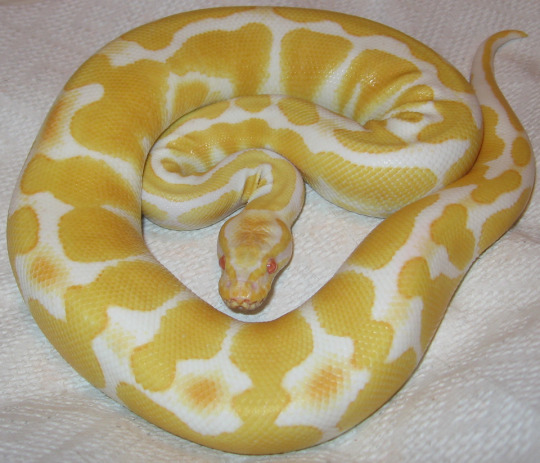
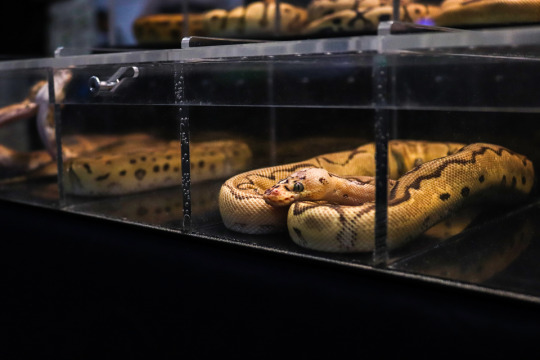

#poll#Class: Reptilia#Order: Squamata#Family: Pythonidae#Genus: Python#Python Regius#Range: Afrotropical
39 notes
·
View notes
Text
I love snakes sooooo much if I had a pet snake i would give it a kiss on its little head every single day theyre soooo cute
#woof#one day i will have a ball python. One day. and I will give him a stupid name#i love birds and snakes i love reptiles so much. Best genus in the world#i know theyre not a genus theyre a class but pretend with me for a moment bc it sounds cooler 🫴 maybe ill name my snake genus
5 notes
·
View notes
Note
https://www.tumblr.com/agoobersretreat/783583252277559296

“I-uhh…Maybe I can satisfy your desire? I have a rather elastic jaw. Comes with what type of lamia I am, python genus if I recall.”
Lula Hase: Bio
Miq perks right up, realizing that someone was talking to her. She turns around to hear where the soft voice is coming from, soon face-to-face with Lula. Or well, more or less.

"Oh? Ummm, well, I think that would be a rather fun thing to try out! If anything, thank you for volunteering! Though, if I may say so Miss, you're the first person in a long time to ask me if I want to be eaten? It's rather kind and very considerate of you, even with the subject matter at hand, ehehehe~."
The peachy-blonde smiles to the other woman warmly and gently, clearly excited and a bit curious by this sudden development for their afternoon.

"Oh, I'm Miq, by the way. It's a pleasure to meet you, and be eat by you, Miss~." Griiiiiiiiiin.
#nexus-of-heavies#lula hase#miq#silliness#shenanigans#nibblin'#cuddly shit#sorry for taking so long#ready to roll though!
14 notes
·
View notes
Text
Python / パイソン and Forsyth / フォルス
Python (JP: パイソン; rōmaji: paison) is a wise-cracking and apathetic member of the Deliverance in Fire Emblem Gaiden and its remake, Fire Emblem Echoes: Shadows of Valentia. Most of you likely know that a python is a type of snake; specifically, the Python genus belongs to the Pythonidae family, consisting of nonvenomous serpents.
Before the name was carried by this subset of snake, the name was attributed to the mythical Python (also called ピュートーン; rōmaji: pyūtōn), enemy of the Greek solar god Apollo. Typically depicted as a great serpent, Python resided at Pytho (later called Delphi), thought to be the center of the world. The story goes (according to Hyginus, at least) that after the goddess Hera learned that her husband Zeus had an affair with Leto, the enraged queen of Olympus sent Python after Leto to prevent the birth of the twins she carried—Artemis and Apollo. Leto found a reprieve, thanks to Poseidon, on the island of Delos and gave birth; not four days after, Apollo would pick up the bow and arrow and sought out Python. Alternatively, some versions tell of Leto and her children leaving Delos for Delphi, only to be attacked by Python once more. All adaptations end the same, however: Apollo brings an end to the serpent by arrows, and Delphi and its oracle would then belong to the sun god. Most likely, the Python in Fire Emblem being an archer was inspired by the mythological beast's slayer.
Forsyth is a straight-laced and passionate member of the Deliverance and Python's best friend. The name Forsyth is Scottish in origin, and has been carried by many notable people. Possible figures that could tie into the character's scholarly background include Scottish theologian P. T. Forsyth and founder of the Royal Horticultural Society and namesake of the forsythia plant—William Forsyth. Also worth noting is the English military journalist and writer Frederick Forsyth and the historic Clan Forsyth of Scotland.
In Japanese, Forsyth is instead called フォルス (rōmaji: forusu), officially romanized as Fols. In Greek mythology, Pholus (JP: フォルス), also called Pholos (JP: ポロス; rōmaji: porosu), was one of the two wise and sophisticated centaurs alongside the more famous Chiron. He appears in the story of Heracles: after the hero captured the Erymanthian Boar, Heracles was offered hospitality in Pholus' cave as he passed through the area. However, when a container of wine was opened, the smell disturbed the wild centaurs in the area, sparking aggression. Heracles would them off with arrows coated in the blood of the Lernaean Hydra, which was capable of inflicting instant death. Pholus, the coward that he was, fled from the battle, but in his curiosity, took to examining a loose arrow, only to drop it on his foot. The gods showed him mercy and placed Pholus in the stars as the constellation Centaurus. (Note that it is common for versions to instead claim Chiron was the one killed by one of Heracles' arrows and made into a constellation).
Lastly, I feel it must be mentioned that there is a very real possibility that these two characters may be named after two programming languages. Python (JP: パイソン) saw its first release in February of 1991,in the middle of Fire Emblem Gaiden's development. Unfortunately, I have no idea how quick Python caught on in the beginning—even less how known it was in Japan in its first year—which is why I feel the Greek inspirations are more likely. That said, Forth (JP: フォース; rōmaji: fōsu) was another programming language made public in the 70's and became very popular in the 80's. Though the katakana used is different, フォルス can still be read as "fo[u]rth," and could potentially have been a stylistic choice.
10 notes
·
View notes
Text

Naja Karamuru
The gorgeous South American dancer Naja Karamuru used two pythons in her act, and sometimes a cobra (from the genus naja). Billed as both "Brazil's Answer to Jayne Mansfield" and "The Peruvian Volcano", her place of birth is obscure.
36 notes
·
View notes
Note
Indie I have an important question
Favourite snake species?
ouhhhhhhhhhh oh god I’m a fraudulent snake enjoyer I DONT HAVE ONE
/silly but I don’t have an exact genus or smthn. but as a generalization. I’d say pythons. and then garden snakes. the way pythons are always curlin around stuff looks rlly cool and absolutely adorable to me. and they give death hugs! and they all look cool.
and I don’t need to explain the appeal of a garden snake. its a little angry spaghetti noodle. what’s not to love
12 notes
·
View notes
Text
The thing about pythons is that they're fat. My kingsnake is as long as I am tall and still fits comfortably in my hands so I'm tempted to think "oh, a 5-6 foot snake isn't that big of a deal, actually". But a colubrid is actually a very svelte animal. A constrictor is not. A constrictor is a magnitude of order more girthy than a colubrid of the same length. Anything that grows larger than a ball honestly gets a little daunting. Bloods might be on the smaller side too, but they make up for that by being as thick as my calves. And what do you mean white-lipped pythons grow 6-9 feet? That's another 50% of the size. That is not a margin of error someone can reasonably account for.
It's also really fucked up that balls and burms are the same genus. That doesn't sound right to me.
3 notes
·
View notes
Note
Tumblr is being a dick
ANYWAY
ReDestro dream and you're at blissful fault.
Haven't watched a bit of MHA but still.
I don't understand what this pithy message is getting at, but hey, let's talk Meta Liberation Army. What haven't I over analyzed yet? How about name meanings?
With Destro and ReDestro, I'd assumed those names were picked out because they sounded close to the word 'destroy' which would make them solid edgy villain names. Actually, 'destro' in Italian/Portugese means, "Right-handed, dexterous, skilled".
According to his wiki, Rikiya's surname is composed of the kanji for "four" (四ツ yotsu?) and "bridge" (橋 bashi?), and his first name contains "power" (力 riki?) and "to be" (也 ya?).
Horikoshi thought his crazy expressions were fun to draw, and he seems to be a mix of many Marvel Superheroes and villiains, such as The Joker, The Penguin, Green Goblin, The Hulk, Professor X.

From Wiki: Chitose's first name is composed of the kanji for "placement, deposit, leave behind" (置 chi?) and "year" (歳 tose?), and her last name contains "spirit, mind, heart" (気 ki?) and "moon" (月 dzuki?).
I plan on including her in future writings, especially since I'm planning on doing a backstory of other characters, so she'd still be alive in that timeline. My head canon is she starts out doing a talk show, and up-and-coming political figure Koku Hanabata will appear a few times. He's more of a celebrity than politician in reality. It's given that he will never win an election or be taken seriously, but he's an effective recruiter for the secret army.

From Skep's wiki: Tomoyasu's first name contains the kanji for "friend, companion" (友 tomo?) and "protect, guarantee, preserve" (保 yasu?), and his last name is composed of "near, close" (近 chika?) and "belong, genus, generic" (属 zoku?).
I thought this one was funny from the beginning, especially in the context of how I write Skep. He's that good friend who's always watching, always keeping you safe through the eyes of the camera. In future writing I may or may not do, Trumpet almost bolts early on, but Skeptic tells him to stay because he can guarantee his safety, and the Grand Commander likes him. He can't guarantee his safety if he leaves because it might be seen as a betrayal.

Image found on Ibispaint.com.
From Wiki: Geten's name translates to "apocrypha," a word that means "story of unknown author or origin" (外典 Geten?). In the Western world, apocrypha most often refers to books not canon to the Bible. IE: Book of Enoch most often referenced on conspiracy sites. In Japanese culture, it could also mean that Geten adheres more to principles of Confucianism while the other generals adhere to Buddist principles.
I've heard fans hate on the guy because he's an aggressive social Darwinist, whereas the others are supposed to be benevolent freedom fighters who strive day and night for quirk social justice, but.....wrongo. ReDestro snapped some innocent mouse assistant guy's neck for calling Meta Liberation War a book for fanatics. Trumpet did a whole spiel about how a weak meta like Spinner couldn't stand a chance against his army, and that Spinner, with his gecko quirk, would never be a valuable member of society.

Trumpet showing off his ability to give a rousing speech and also unhinge his jaw like a reticulated python so he could eat a foot long sub in one bite if wanted. Okay, I jest but.....
....from Wiki, Koku's first name contains the kanji for "cavity, hole, slit" (孔 ko?) and "body cavity" (腔 ku?), and his surname contains "flower" (花 hana?) and "field" (畑 bata?).
I've most often seen his name come up as "Cavity Flowergarden" during translations on Japanese sites. That sounds a lot less awkward than orifice or hole. I'm still bound and determined to call him 'Cunty' though. Fight me.
It's still in the plans to make him miserable in fan fiction. I once played around with the idea on LJ to make a Trumpet's Trauma Trifecta where I'd break an all-time record for length writing a tale of comedic suffering. It might be called Missus Yotsubashi (I'm not sure yet because I'm not going to commit to something until the outline gets started. Right now, I'm in the planning stage) where ReDestro is happily married, but his wife finds out about the boner he has for a certain politician and loyal general of the MLA. Awkward situations ensue.
#meta liberation army#redestro#rikiya yotsubashi#geten#skeptic#curious#trumpet#koku hanabata#tomoyasu chikazoku#chitose kizuki
5 notes
·
View notes
Text
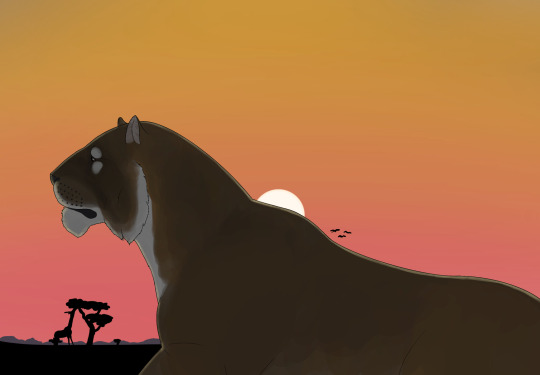
The sun is rising on the savannah. An old cat is resting amidst the grassland. He looks at the territory he held for almost six years at this point, much longer than almost any other male of his species. He’s a Machel’s lion (Leorex macheli), the apex predator of Aethiopia.
This new continent split from mainland Africa just before the interchange and was thus unaffected by it, with many lineages declining or extinct in Afrolaurasia still thriving here, east of the Great Rift Valley and the African Great Lakes.
Moving eastwards and exposed to the currents of the newly formed sea this continent’s climate is slowly but steadily changing. With the Asian monsoons now finally reaching the Eastern coast the first coastal forests are popping up on the edges of the Horn of Africa’s desert, and thanks to the rains brought from the West and strengthened by the equatorial currents the Lake Victoria rainforest was able to expand.

This rainforest is one of the most biodiverse areas of Earth, being so small in size but still hosting so many species. It’s inhabited by a wide array of wildlife. The largest are the ground dwelling primates, the pomorangs (Kampalapithecus chimpiskii), and the many forests antelopes of the genus Relictotragus, or kasolyas.; reptiles and birds alike inhabit the forest, with the most notable ones being pythons, water monitors, parrots and the junglefowl introduced in the Holocene; and a lineage extinct in the rest of the world is still found here, the Smutsiinae, with the still thriving East African giant pangolin (Catiosmutsia aethiopica).
The savannah doesn’t differ much from that of the Anectyocene, with cats, antelopes, dogs, perdvarks and gouebeervarks still being the most common sight there. The main difference here is the evolution of the tomeutheriid, and thus hyracoid, Zoshkoko (Tomeutherium ingens), the largest land animal of the continent, reaching 4 metres in height and rivaling the Pleistocene straight tusked elephant at around 14 tons in weight.
In the last million years there has also been a remarkable case of convergent evolution, with a population of laangvos adapting to a more frugivorous diet and establishing a symbiotic relationship with the Kei apple, eventually evolving into the shaggy wolf (Phytocyon keiophilus), uncannily similar to the maned wolves of South America.

#spec evo#spec bio#speculative evolution#speculative biology#worldbuilding#artwork#digital art#epigene period#future earth#future evolution
10 notes
·
View notes
Note
Do you find corn snakes have more personality than some other species?
Hey friend!
Well... Hmm. I don't know that I'd say more personality. I'd say more of the personality traits I personally gravitate towards.
All snakes have personalities and individual preferences and avoidances. I've worked professionally with large snakes, small snakes, and venomous snakes and no two of the same species were exactly alike in terms of temperament. The old belief that a ball python is a living "pet rock" has been dispelled by simply giving these animals appropriate enclosures. Most of the animals we consider "less intelligent" or "primal" by human standards lead rich inner lives that we just can't anthropomorphize into something personally relatable.
North American ratsnakes are generalist hunters, not ambush predators, and they are often secondary or tertiary consumers in their food webs, meaning they're both predator and prey. They are active and curious, sometimes verging on anxious. They want to know what's going on, who's nearby, what they're doing. Is it food? Is it danger?
They tend to rely on crypsis and threat displays for defense, meaning they do not benefit in nature by being overtly aggressive. This makes them a great candidate for captive keeping. The corn snakes we keep in captivity have been selectively bred for tameness and calmness along with color expression over many generations, amplifying their natural proclivity for being pretty chill with humans.
The more time you spend learning about and interacting with an animal, the better you know that animal, right? I gravitated towards corn snakes because of their variety of color morphs and ease of keeping and I've kept corn snakes for 15 years or more, both professionally and as a hobby. Maybe I like the snakes in genus Pantherophis best because I've spent the most time with them and I know their expressions and behaviors well enough to be able to read them.
I'm sure if you were to ask an alternate universe version of me who kept Burmese pythons the same question, I'd give roughly the same answer.
#snake#snakes#reptile#reptiles#reptiblr#corn snake#corn snakes#answers to questions#text post#snake keeping#snake behavior#snake husbandry#Why I Love Corn Snakes: an essay by me
29 notes
·
View notes
Note
favorite snake?
((all images I got were from Google!))
"Favorite snake" can entail (pun intended!) a lot of things. Do you mean my favorite snake I have? My favorite species? Or maybe my favorite genus?
My favorite snake out of the ones I have is Stefan, my Burmese Python. Burmese Pythons are also my favorite species of snake! And pythons are my favorite genus. I love pythons!!!

((image creds))
They're big and cuddly snakes who quite literally hug their prey to death. If I'm gonna be killed by a pet snake, I'd want to go out being cuddled. Their scales can also look iridescent under the right lighting! This was the best picture I could find (which isn't very supportive to my point...)

((image creds))
Burmese Pythons are absolutely huge!!! Stefan is eleven feet long, but some burmese pythons can get over twenty feet long!

((image creds))
Thanks for being curious about my snakes!! (≧▽≦)
#((i think i got all my info accurate?#((but does it really matter? this is a rp account#tkdb#tkdb oc#tokyo debunker roleplay#tokyo debunker#askallianything#tokyo debunker oc roleplay#tdb#tkdb oc roleplay
3 notes
·
View notes
Text
hello it is time for a VERY niche post. join me for... SHL characters as SNAKES!!!!! i tried to find snakes that naturally occur in china or near china, as a terrible added parameter—there's a TON of snakes in china, but i just don't know many so it's terrible bc it added a lot of work for me lol. but i've learned things! and found some cool snakes! so! let's go. pictures of snakes ahead, if that's not your thing, feel free to peace out.
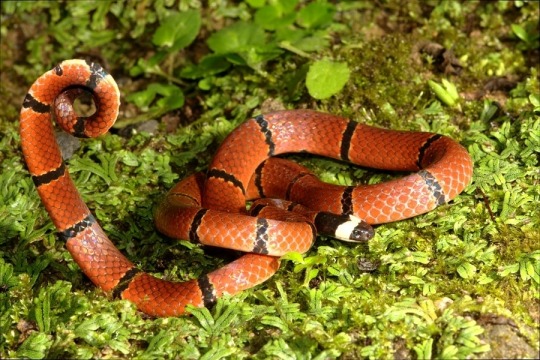
Wen Kexing - Sinomicrurus macclellandi a coral snake! just a nice boy you know? just a nice, extremely venemous boy with dramatic red coloration. shamless plug for my fic where wkx turns into This Snake.
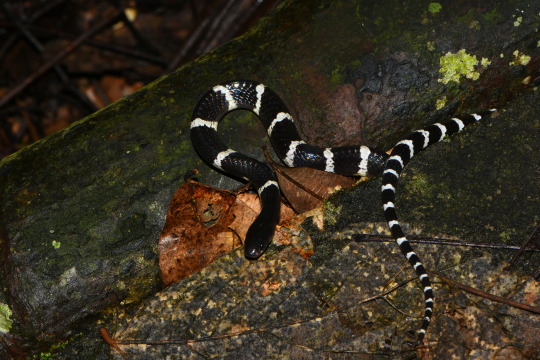
Zhou Zishu - Bungarus multicinctus look at this lovely unassuming snake. got some goth-y drama but overall not too bad, right? one of the most venomous land snakes in the world 😌 (also. he and wkx match but like in a complimentary way.)
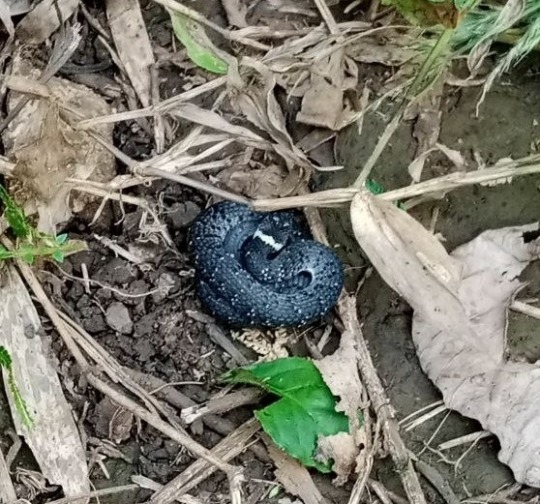
Zhang Chengling - Pareas margaritophorus the first thing wikipedia says about this snake is that it is small and harmless. for the first time so far, i am not trying to mislead you. just a little snek boi!!!!!! cute!!!!!! I Want To Hold And Protect Him
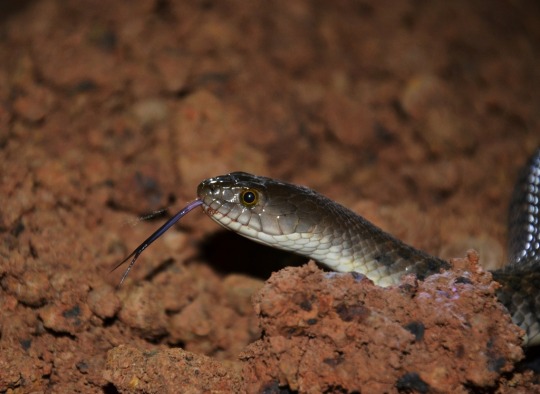
Gu Xiang - Fowlea piscator look i'm gonna be honest. there are not a lot of snakes that are even REMOTELY purple but this one has a little purple whip tongue! also, not venemous but (if it's anything like water snakes in the US) kind of an asshole. apparently pretends to be a cobra. look at her go.
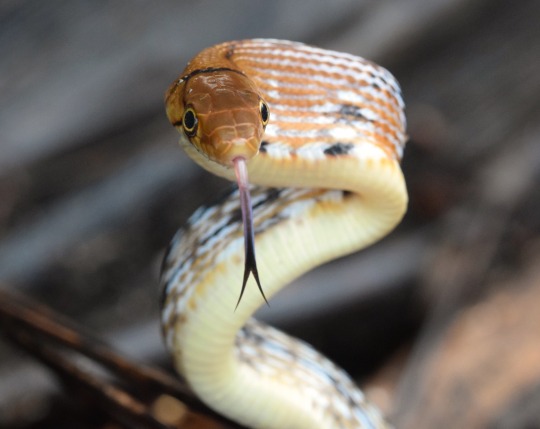
Cao Weining - Coelognathus radiatus this snake has no thoughts in its head. look at it. i don't mean as a species i mean This One. That's cwn. just sitting there doing a blep. no venom, apparently a defensive sort of dude. cool colors tho!

Luo Fumeng - Calliophis bivirgatus a different kind of coral snake! i've gone a bit further outside of china for this one but LOOK at how gorgeous it is. how could i not let lfm be this glamorous. also i like the idea that she's a different genus of snake than wkx but still a (venemous) coral snake.
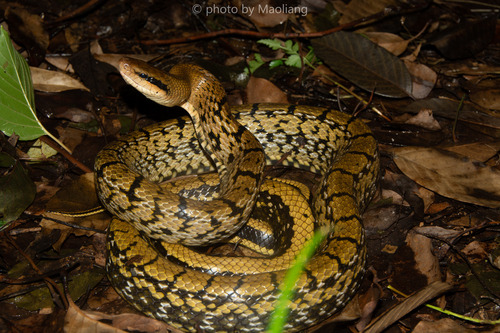
Liu Qianqiao - Elaphe taeniura gonna be honest here, the common name of this snake in english is the beauty snake (or ratsnake), so i didn't think too much farther. there's a ton of different color morphs of it. look at it, the elegance! she's beauty she's grace she'll constrict you (if you are a small mammal)!
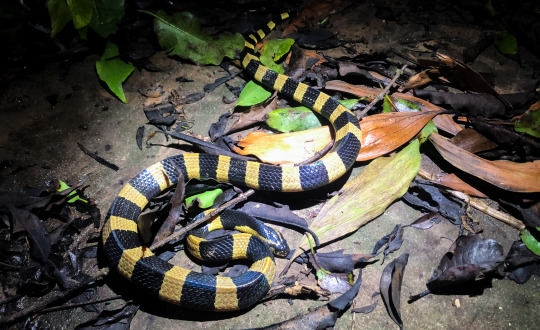
Xie Wang - Bungarus fasciatus this is a different krait! zzs has MANY bands, xw just has bands. a little brighter colored and more extra than zzs, sliiiightly less deadly, still can very definitely kill you. LOOK at that warning coloration. if i was to pick two characters to DEFINITELY have warning coloration, it WOULD be wkx and xw.
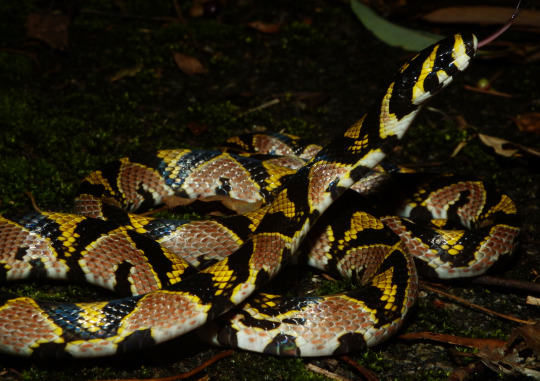
Du Pusa - Euprepiophis mandarinus this is NOT my best work, but i just thought this snake was really pretty and so i was determined to include it somehow. hence: dps. they are ~secretive~ apparently. also. again. Look At It
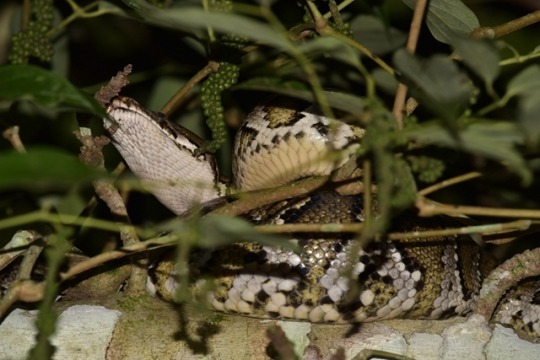
Ye Baiyi - Python bivittatus BIG BOY!!!! ALMOST THE BIGGEST BOY!!!!! does occur in white color morphs in captivity (and like, i guess presumably in the wild? at one point? but i have to imagine that's like. not so much a thing anymore.) also, did i pick the picture that looks the most like a cryptid? of course i did, it's yby. he doesn't want his picture taken. he doesn't want you to know he exists even. leave him alone. where he belongs in his natural habitat.

Han Ying - Lycodon septentrionalis a shiny pretty boy. a shiny pretty boy who looks very much like a many-banded krait, in fact. however, they're not venemous. hy just looks like zzs. again: LOOK AT THIS GOOD SNEK.
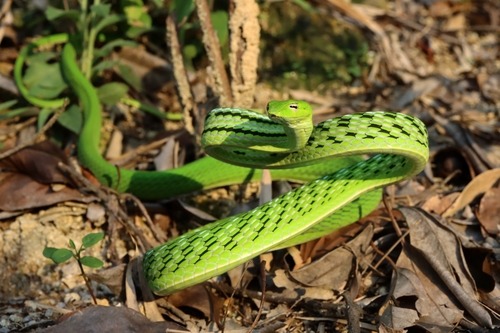
Jing Beiyuan - Ahaetulla prasina several things here. one, this is an elegant but strange boy (i don't think this shows just how weird this guy's nose looks. it's like someone took a snake's nose and used pliers to stretch it out all pointy). two, FASHION!!! look at those pattens!!!!! a striking example. and three, it looks kind of like wu xi's snakeclet
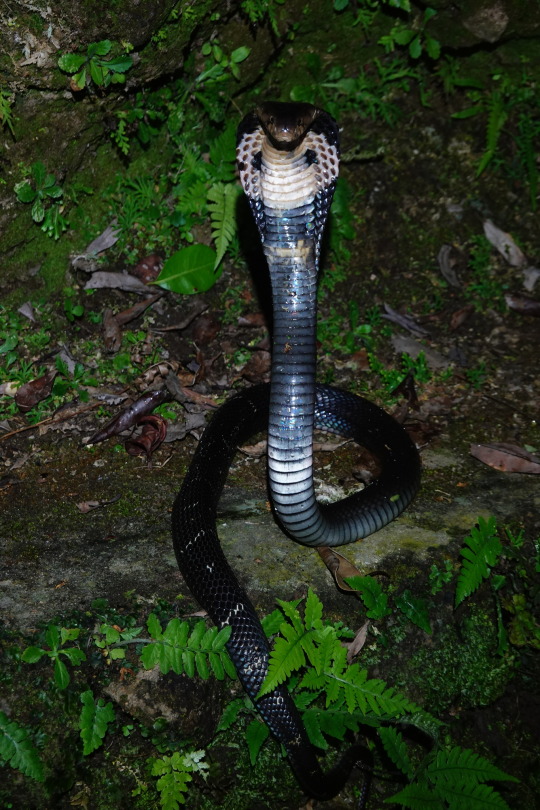
Wu Xi - Naja atra he's a cobra. i think this speaks for itself.
#snakes cw#PLEASE listen to the content warning for SNAKES if you don't like PICTURES OF SNAKES#shl#blame and or thank siv for this <3
18 notes
·
View notes
Text
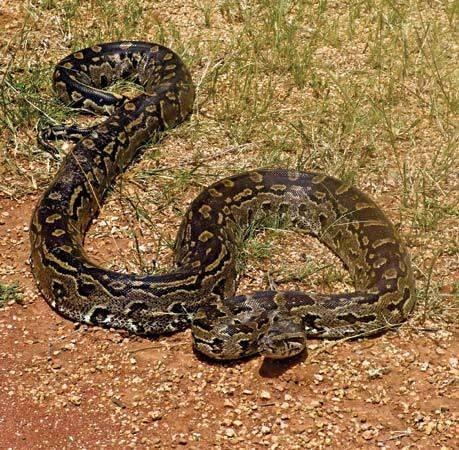
African rock python is a species of large constrictor snake in the family of Pythonidae.
The species is native to Africa. It is one of 10 living species in the genus Python. Africa's largest snake and one of the eight largest snake species in the world
African rock pythons have a thick body covered with colored blotches, often joining up in a broad, irregular stripe. Body markings vary between brown, olive, chestnut, and yellow, but fade to white on the underside.
The head of these snakes is triangular and marked on top with a dark brown “spear-head” outlined in buffy yellow.
African rock pythons are non-venomous and snakes they don’t have fangs.
The snake is widely feared, though it very rarely kills humans
African rock python’s lifespan is 20 – 30 years but the might live even longer in the wild.
You’ve probably heard that snakes have poor eyesight. This is true!
African rock pythons. They aren’t blind, but they don’t perceive much with their eyes; instead, they rely on a complex sensory organs in and around their face.
The tongues of African rock pythons are able to “smell” the surrounding environment. If a prey is nearby, their tongues will sense it.
African rock pythons have heat-sensing pits in their scales that
Helps them locate both predators and prey.
African rock pythons start to mate with each other when they’re around 3 – 5 years old.
African rock pythons are solitary creatures that prefer to live and hunt alone. The exception to this is the mating season; they’ll come together to breed, but it doesn’t last long, and males leave the females as soon as they start nesting.
African rock pythons are most active at night, especially when they’re trying to hunt.
2 notes
·
View notes
Text
NEOGEO BATTLE COLISEUM SUPER ULTRA RUMBLE
NEOGEO BATTLE COLISEUM YUKI-MICHAEL RUSSELL AI-JENNA FRANKLIN WORLD HEROES HATTORI HANZO-FREDDIE BENJI FUMA KOTARO-JASON CORE RASPUTIN-VLADIMIR.P JANNE D'ARC-AMBER HARRIS-DILLER JENGHIS-KEVIN MICHAEL RICHARDSON BROCKEN-ARNOLD MULLER KIM DRAGON-COREY.T MUSCLE POWER-PATRICK SMITH CAPTAIN KIDD-JUSTIN UNO ERICK-COREY SWANSON JOHNNY MAXIMUM-ALAN RITCHSON MUDMAN-RUSSELL LUCAS RYOKO IZUMO-MASHA CARSON SHURA-CHANG LI RYOFU-SHANG THANG JACK-KENNY RICHARDS SUN WUKONG-ERIC.GEOSKI.III AGGRESSORS OF DARK KOMBAT JOE KUSANAGI-KYOSHUA KHAN KISARAH-NAUTICA JOHNSON GOH KIDOKORO-MATTHEW MARCHAND LEONHALT DOMADOR-RICO GOMEZ SHEEN GENUS-ALVIN-DAVID.G LEE HAE GWON-PATRICK SEUNG BOBBY NELSON-MILTON BUTLER.JR VOLTAGE FIGHTER GOWCAIZER GOWCAIZER-MIKEY HARRIS HELLSTINGER-KOREY MONROE KARIN SON-ASHLEY WONG-HENDERSON KYOSUKE SHIGURE-JERMIAH MALONE SHAIA-TARA STRONG BRIDER-STEVEN BLUM FUDOHMARU-SHINSUKE.E CAPTAIN ATLANTIS-ALAN LENDALE MARION-BRENDA BROWN-COLLINS SHENG-LONG-HARRISON RANDELL THE MAIN BOSS VINCENT ALBERT-CHAEL SONNEN SAVAGE REIGN SHO HAYAYE-BRYAN DANIELSON CAROL STANZACK-TRESS MACNEILLE MAX EAGLE-VANCE RICHARDS.JR GORDON BOWMAN-BRYAN CRANSTON CHUNG PAIFU-ALBERT SHING GOZU-AARON PAUL MEZU-MATT JONES JOKER-MATT HARDY NICOLA ZAZA-MATTHEW MERCER KING LION-MARK LINDSEY KING LEO-PHIL LAMARR ROSA-BRITTANY CASTILLO KIM SUE II-STEVEN YEUN JYAZU-KEITH DAVID BREAKERS SHO KAMUI-SAMMY GUEVARA LEE DAO-LONG-BENNY SHAU TIA LANGRAY-SERENA DEEB PIELLE MONTARIO-ANDRADE.XAVIE CONDOR HEADS-TENOCH HUERTA SHEIK MAHERI-BOBBY RICKS RILA ESTANSIA-TAY MELO-GUEVARA ALSION III-RAFE SPALL HUANG BAI-HU-CARY-HIROYUKI TAGAWA SAIZO TOBIKAGENO-ROBIN SHOU Buriki One GAI TENDO-MARCO.ALBE ROB PYTHON-CHRISTOPHER JUDGE JACQUES DUCALIS-DAVID.GUY SEO YONG SONG-KENNETH COOPER TAKATO SAIONJI-MICHELLE-SUSAN BENSON PAYAK SITPITAK-HAKEEN JOHNSON SONG XUANDAO-VANDER RHODES.SR PATRICK VAN HEYTING-JORDAN QUIALBA IVAN SOKOLOV-BE.ATY SILBER-JOHN DIMAGGIO RAGE OF THE DRAGONS BILLY-TYLER MARCHAND LYNN-MILA KUNIS JIMMY-JOSEPH BENJAMIN SONIA-RACHEL MACFARLANE RADEL-MARCUS VANCER.JR ANNIE-RACQUEL ZACHARY-BERNARD CASSANDRA-EMILY BERGL ONI-TONY ANSELMO PEPE-ESB.F PUPA-RASHA.WIL ALICE-BRENDA’‘BONNIE’’.BONNI ELIAS-PATRICK.U MR.JOHNNY D.JONES-BRIAN TYREE HENRY KANG JAE-MO-PATRICK WARBURTON ABUBO RAO-Kumail Nanjiani JOHANN-KEN SHAMROCK
1 note
·
View note
Text
Did you know the Pythonidae family is home to about 39 species? They live in Africa, Asia, and Australia. This family includes the famous Burmese python, with hundreds of thousands in Florida's Everglades. These snakes are big and interesting, and they play a big role in their ecosystems. We will explore the python family in detail. We'll look at their classification, behavior, where they live, what they eat, how they reproduce, their conservation status, and their relationship with humans. Key Takeaways The Pythonidae family contains around 39 species and 10 recognized genera. Burmese pythons are a significant introduced species in Florida, with around half a million individuals. Reticulated pythons are among the longest snakes, with some individuals measuring over 10 meters (32.8 feet). Pythons are known for their exceptional hunting techniques and possess heat-sensitive pit organs. This family of snakes lays eggs and, in most species, the females provide warmth to their clutch. Introduction to Pythonidae The Pythonidae overview shows us a fascinating family of snakes called pythons. They are nonvenomous and have about 3789 species. These snakes are among the biggest and strongest in the world. The reticulated python, the largest, can be over 30 feet long. The smallest python, Antaresia Perthensis, is just 24 inches long. This shows the wide range in size within the family. Pythons characteristics stand out in their physical traits. Adults usually weigh about 12 kilograms and are 3 to 6 feet long. Some can even reach up to 23 feet long. They don't have eyelids but have a transparent scale to protect their eyes. Their colors help them blend in with their surroundings, which is key to their survival. The python family introduction also highlights their unique way of reproducing. Female pythons lay between 2 to 100 eggs, depending on the species. After laying eggs, they protect them by coiling around them. Pythons can live for 25 to 35 years, which is quite long for reptiles. https://youtube.com/watch?v=fikJIxMKSeQ Pythons live in warm and wet places like rainforests, grasslands, and woodlands. They are found in Asia, Africa, Oceania, and Australia. But, many species are threatened by habitat loss and poaching. This is why some are listed as vulnerable on the IUCN Red List. What is the Python Family? The python family, known scientifically as Pythonidae, includes large, nonvenomous snakes. They are famous for their unique way of catching prey. This group has about 72 species and is divided into 14 living genera. The variety within the pythonidae classification shows their complex evolution and adaptability. Some well-known genera are Antaresia with six species and Morelia with ten. Others like Python and Liasis also have many species. Each genus has its own special traits, showing how they adapt to different places. Most pythons live in the tropics and subtropics. They can be found from sub-Saharan Africa to Southeast Asia and northern Australia. Unlike many snakes, female pythons lay eggs, which sets them apart from the Boidae family. Even though a few big pythons can be a concern, especially as pets, they are crucial to ecosystems. As nonvenomous snakes, they help keep their habitats healthy by controlling rodent and small mammal populations. GenusNumber of Species/SubspeciesAntaresia6Apodora1Aspidites2Bothrochilus1Leiopython3Liasis6Malayopython5Morelia10Nyctophilopython1Python13Simalia6 Classification of Pythonidae The pythonidae taxonomy is complex, with many genera that show the variety of this snake family. Important genera are Python, Morelia, and Antaresia. Each species is well-suited to its environment. The family has 44 recognized species, including four subspecies. This classification shows how pythons, sunbeam snakes, and some boas are related. Classification of snakes has changed over time. This has led to the discovery of new species and changes in how they are grouped.
Here is a detailed overview of some important genera and corresponding species within the Pythonidae family: GenusSpeciesCommon NamePictures AvailablePythonbrongersmaiRed Blood Python1PythonmolurusIndian Python3PythonregiusBall Python3PythonreticulatusReticulated Python2PythonsebaeAfrican Rock PythonInformation AvailablePythontimoriensisTimor PythonInformation Available The genus and species of pythons are key to understanding their evolution. New species are still being found, showing that we know only a small part of the family. Between 2000 and 2013, twelve new species were added to the classification. Studies have shown complex relationships among pythons, revealing a deep evolutionary history. Characteristics of Pythonidae The Pythonidae family stands out with unique traits. Their physical features and behaviors offer clues to their survival skills. Physical Features of Pythons Pythons are known for their strong muscles. These muscles help them squeeze their prey. They range from 1.5 feet to 33 feet long, showing a wide variety among species. Some pythons are over 20 feet long. Others, like the pygmy pythons, are less than 2 feet long. Here are some key physical traits: Robust muscular structure for effective hunting. Dual lungs—an ancient trait among snakes—allowing for efficient respiration. Backwards-facing teeth that enhance their ability to consume prey that is larger than themselves. Skin patterns that vary, with about one-third of species being almost patternless, and some capable of dramatic color changes. Behavioral Traits of Pythonidae Pythons hunt by ambushing their prey. They wait patiently and use camouflage to hide. Most live alone, fitting into different habitats like deserts, savannas, or rainforests. They are mostly active at night and defend themselves when threatened. Pythons mainly eat vertebrates like lizards, mammals, and birds. Attacks on humans are very rare. These traits show how pythons survive in various places. Distribution and Habitat of Pythons Pythons show how adaptable and resilient they are in different places. They live in many parts of sub-Saharan Africa, Southeast Asia, and Australia. These areas have various climates and ecosystems, showing how well these reptiles fit in. Global Range of Pythonidae Species Pythons live in both their natural and new homes. They can be found in: RegionStatusNearcticIntroducedPalearcticNativeOrientalNativeEthiopianNativeNeotropicalIntroducedAustralianNative Preferred Habitats of Pythons Pythons live in many different places, showing their adaptability. They like living in: Tropical Rainforests Temperate Forests Marshes and Swamps Bogs Grasslands Urban Areas Agricultural Lands They can live up to 1,200 to 2,500 meters (3,937 to 8,202 feet) high. Being good swimmers, they also live in wetlands and by the coast. The Burmese pythons in Florida show how they can move into new places. This highlights the need to understand where pythons live for conservation and management. Feeding and Nutrition in Pythonidae Pythons are skilled hunters known for their remarkable feeding habits. They use stealth, patience, and precise technique to hunt. This lets them thrive in diverse environments. Let's take a closer look at their hunting techniques and dietary preferences. Hunting Techniques of Pythons Pythons mainly use ambush tactics to catch their prey. They blend into their surroundings with excellent camouflage, waiting for animals to come close. Their hunting techniques include: Infrared Detection: Pythons have special heat-sensitive pits on their face. These pits help them detect infrared radiation from warm-blooded creatures. This helps them find prey even in complete darkness. Constriction: Once a python grabs its prey, it wraps its body around it to suffocate it before eating. Swallowing Technique: Pythons have a unique way of swallowing large prey. They produce mucus to help the prey go down their long throat.
Dietary Preferences of Python Species The diet of pythons varies by species and habitat. Generally, they eat: Prey TypeCommon ExamplesMammalsRats, mice, small deerBirdsChickens, wild birdsReptilesOther snakes, lizardsOccasional AmphibiansFrogs Pythons' diet is key to their growth and health. Getting the right nutrition helps them live up to 30 years with proper care. Knowing what they eat is important for both wild and captive pythons. Reproduction and Lifecycle of Pythonidae Pythons are fascinating snakes that lay eggs. They have unique ways of reproducing. The female python wraps her eggs to keep them at the right temperature for growth. This is called thermoregulation and shows how pythons adapt to their environment. The lifecycle of pythons includes several stages. Female ball pythons become ready to have babies between 27 and 31 months old. Males are ready a bit earlier, at 16 to 18 months. The eggs take about 44 to 54 days to develop, usually laid from mid-February to early April. Hatchlings come out from mid-April to mid-June, when it's best for their survival. The Burmese python has a different approach. They can lay up to 100 eggs at once. Female Burmese pythons become ready to have babies around 2 to 3 years old. Their eggs develop in just 2 to 3 months, which affects their numbers. Pythons can live a long time, up to 20 years in captivity. In the wild, they usually live about 10 years. Their long life, controlling rodent populations, and helping rural communities shows why we need to understand them better. SpeciesReproductive Maturity (Months)Gestation Period (Days)Clutch Size (Average)Average Lifespan (Years)Ball Python (Python regius)27-31 (Female), 16-18 (Male)44-544020 (Captivity)Burmese Python (Python molurus)24-36 (Both)60-9040-10015.8 (Captivity) Conservation Status of Pythonidae Many python species are in danger due to habitat loss, poaching, and illegal trade. For instance, reticulated pythons, the longest snakes, are at risk because they are popular pets and used in traditional medicine. Efforts to protect these endangered species include laws against illegal capture and promoting sustainable living in their habitats. Python protection is becoming more important, especially for the Indian python and ball python. The International Union for Conservation of Nature (IUCN) says reticulated pythons and ball pythons are not endangered. Ball pythons are doing well thanks to conservation efforts, even with the pet trade. But, we still need to be aware and take action. The wild ball python population is stable, but taking too many for pets could threaten their future. Python SpeciesConservation StatusLife ExpectancyEgg Clutch SizeThreatsReticulated PythonLeast Concern22 years in the wild, 32 years in captivity20-50 eggs (up to 100 recorded)Illegal trade, habitat loss, human conflictBall PythonLeast Concern20-30 years in captivity, shorter in the wild4-10 eggsPet trade, habitat degradation We need to work together to protect these amazing snakes. Governments, conservation groups, and the public must act. Supporting responsible pet ownership and avoiding wild-caught snakes is crucial for their future. Relationship Between Humans and Pythonidae Humans and pythons have a complex relationship. These snakes are seen as symbols of strength and resilience in many cultures. But, their relationship with humans can be both good and bad, especially in traditional medicine and the python trade. The Role of Pythons in Traditional Medicine In some cultures, pythons are seen as having healing properties. Different parts of the python are used for various treatments. This shows how deeply pythons are connected to local traditions and nature. Impact of Python Poaching and Trade The python trade has grown into a huge industry, driven by demand for their skins and meat. This has led to a big threat to their survival. Conservation efforts are working to reduce the harm of python trade and teach people why we need to protect these reptiles.
Conclusion This journey into the python family shows us how complex and important they are. These snakes play a key role in nature. They have many behaviors and adaptations that help keep ecosystems balanced. It's crucial to protect them as their homes are being destroyed and they are being hunted. There are 44 recognized species of Pythonidae, each with its own story to tell about evolution. Research is ongoing, and we might discover more about these snakes. Humans and pythons have a special connection, showing how important they are to us. We need to work together to protect pythons. By spreading the word about why they matter, we can help communities and leaders understand their value. This way, these amazing snakes can keep living in their natural world, helping our planet stay healthy and full of life. StatisticDataTotal Species in Pythonidae44 speciesNew Taxa Described (2000-2013)12 new taxaTaxonomic Coverage Range0.30% to 0.77%Geographical DistributionSub-Saharan Africa, Asia, Indonesia, Philippines, Papua New Guinea, AustraliaFirst Species DescriptionLinnaeus in 1758Total Identified by 19th Century13 species by 19th centuryTotal New Species in 20th Century15 speciesPotential New DiscoveriesExpected in Southeast AsiaHealth Benefits of Python MeatLow fat and cholesterolSustainability of Python FarmingLower environmental footprint References To understand the Pythonidae family, we need many research sources. Barker and Barker's work on taxonomy is key. They also look at where pythons live. Ashraf explores the geographical spread of pythons, adding to our knowledge. Studies like McDowell's catalogue of snakes show pythons' roles in their ecosystems. The variety of species mentioned highlights the need for conservation. References cover everything from the Burmese Python to Australian species. These studies stress the importance of protecting pythons. They inform us on how to monitor their habitats and breed them. They also talk about the challenges of climate change and invasive species. Research on Pythonidae shows we need to keep learning and protecting these reptiles. Using these sources helps us appreciate the Pythonidae family more. It's crucial for their survival. FAQ What are the main characteristics of the Pythonidae family? The Pythonidae family includes large, nonvenomous snakes. They are known for their strong muscles and unique looks. These snakes hunt by ambushing and have special teeth for eating large prey. How are Pythonidae species classified? Pythonidae species are classified into several genera like Python, Morelia, and Antaresia. Each species fits into a specific environment. Their classification shows how they are related to other snakes. Where are pythons primarily found? Pythons live mainly in sub-Saharan Africa, Southeast Asia, and Australia. They live in many places, from forests to grasslands. They are good swimmers and adjust to different climates. What do pythons eat? Pythons eat mammals, birds, and sometimes reptiles and amphibians. They hunt by ambushing and have a special way of swallowing their prey with the help of mucus. How do pythons reproduce? Pythons lay eggs that the female coils around to keep warm. This helps the eggs develop properly. What threats do Pythonidae face? Python species are threatened by habitat loss, hunting, and the illegal wildlife trade. We need conservation efforts to protect them and their homes. How do humans interact with pythons? Humans have many interactions with pythons, like using them in traditional medicine and trading their skins. But, poaching and exploitation threaten their survival. We need sustainable practices to help them.
0 notes
Text
Research - Serpentine Dragon Mythology
I decided to look into different serpentine dragons from across the world. Many serpent-like dragons were associated with water in some way, which is why I want my character to resemble the more snake-like dragons throughout mythology.
Beithir
Beithir is a large snakelike dragon from Scottish folklore. The word Beithir means 'serpent', 'lighting', and 'thunderbolt' in Gaelic. The creature has also been referred to as beithir-nimh, meaning 'venomous serpent,' and nathair, meaning 'serpent'.
It's described to be the largest type of serpent, and is supposedly born out of severing the head of a snake. if the snake's head is not carried far away enough from the body then it reattaches and becomes a Beithir. It's described as a venomous dragon with wings and fire breathing that lives in mountainous areas. Folklore dictates that if one is stung by a Beithir then they must hurry to the nearest body of water. If the Beithir reaches it first then the person dies. A Beithir is classified as a fuath, who are malevolent spirits associated with water.
Knucker
The Knucker is a serpentine water dragon from English folklore found in round deep pools of water known as knuckerholes. The word Knucker comes from the old English word nicor, which means 'water monster.' It could also possibly be related to the term 'nixie' which is a type of water spirit. The Knucker is described as looking like a sea serpent.

Agathodaemon
Agathos Daemon was a serpent-like lesser deity from ancient Greek mythology and Graeco-Egyptian religion. Agathos Daemon translates to 'noble spirit.' He was the god of vineyards, fields, fertility, grain, and health and as a household god, it was customary to honour him before meals. Later on the term was used to refer to a genus of serpentine household spirits known as the Agathoi Daimones. They were seen as protectors of the homes in which they were worshipped.
Serpents are associated with healing in Greek mythology. The second day of every lunar month and the second day of every athenian month was dedicated to the Agathos Daemon. This is because the crescent moon shape resembled Hermēs' staff, kerykeion, which featured two serpents.


Bakunawa
Bakunawa is a large serpent or dragon from Philippine folklore. It was cited as the cause of natural disasters and phenomenons such as earthquakes, eclipses, rains, and wind. The movements of the Bakunawa was also used as a calendar system for ancient Filipinos and were even part of certain religious rituals. Bakunawa is a term from proto-Western-Malayo-Polynesian, roughly meaning 'bent snake' or 'curved python.'
Versions of the Bakunawa also existed in other myths in the Philippines, the most similar being Laho, a serpent-like dragon that causes moon eclipses, and Láwû, a bird-like dragon or serpent that causes both solar and lunar eclipses. Both the words laho and láwû mean "eclipse."
Pre-colonial Cebuano mythology believed that their creator, the god Bathala, created 7 moons to light up the sky. The Bakunawa, amazed by their beauty, would rise from the ocean and swallow the moons whole, angering Bathala and causing them to be mortal enemies.
In order to prevent Bakunawa from swallowing all the moons, ancient Filipinos would go out of their homes with pans and pots, and would bang on them to make noise in order to scare the Bakunawa into spitting out the moon back into the sky. Some of the people in the villages would play soothing sounds with their musical instruments, in hopes that the dragon would fall into a deep sleep. The dragon was referred to as 'moon eater.'
In West Visayan mythology, when Bathala saw Bakunawa swallow six of his seven moons he planted bamboos on the 7th moon, giving the moon its round craters and stains.
Gaasyendietha
Gaasyendietha is a dragon from Seneca Mythology (from First Nations People in Canada). Also referred to as 'the meteor dragon,' it is a giant serpent that lives in deep fresh water such as rivers and lakes. In First Nations cosmology, serpents are often related to waterbodies, and Gaasyendietha was often associated with Lake Ontario.
The dragon could not only breathe fire but also travel along a trail of fire in the sky. It is also capable of crossing the heavens with this trail of fire.


In the late 1800s, aided by claimed sightings of the beast, Gaasyendietha started being referred to as Kingstie. Kingstie was described as a blueish-grey snake-like beast over 9 meters long with short legs, a tail, and prominent bristles.

Ikuchi
Ikuchi, also known as ayakashi, is a yōkai from Japanese legend. It is described as an extremely long sea serpent/fish that lives in the deep waters off Hitachi Province. It is said to only come out at night, sometimes rearing out of water and slinking over a ship, taking a long time to complete its passage (sometimes even days), and leaving a residue of viscous oil. The oil needs to be removed off of the ship lest the sheer volume causes it to sink. It is not very big in thickness but spans the length of several thousands of feet.

Jörmungandr
Jörmungandr, also known as the Midgard Serpent or World Serpent is a dragon from norse mythology. It is described as an incomprehensibly large se serpent/worm. It lives in what is described as the 'world sea,' which is the sea surrounding Midgard (the human realm). Jörmungandr is an ouroboros that encircles the entire world, which is where the name 'world serpent' comes from. It is said that when Ragnarok comes, Jörmungandr will let go of its own tail.
Jörmungandr is one of the three children of Loki and Angrboða (a giantess), with the other two being Fenrir wolf and the goddess Hel. According to Norse myth, Odin cast the three children out of Asgard. Jörmungandr was thrown into Midgard, where it grew to span across the earth and swallow its own tail. Thor and Jörmungandr have a longstanding feud, and are fated to fight once Ragnarok comes.
The name Jörmungandr comes from Old Norse. The prefix jǫrmun- means 'huge', 'vast', or 'superhuman.' The following word gandr is a term used to describe long, supernatural entities, but can also mean 'snake', 'fjord', 'rivier', 'staff', 'stick', and 'bind'. Therefore, the name Jörmungandr could have several meanings: "the vast serpent", "the vast river", "the vast staff/stick" (in reference to the world tree?), or "the vast bind" (in reference to it binding itself around the earth).

Leviathan
Leviathan is an impossibly large sea serpent from the Hebrew bible. The Leviathan was the embodiment of chaos and encapsulated the space of the material world. Leviathan was often represented as the devil.

Morgawr
Morgawr is a sea serpent from Cornish folklore, hailing from Falmouth Bay, Cornwall, England. It is described as having a trunk with a very long neck and black or brown skin similar to that of a sea lion's.
Seelkee
A sea serpent from First Nations folklore in Canada. A Seelkee is 10 - 15 feet long, black in colour with red circular patterns, and has the head of a horse. Some stories describe the creature having two heads.
Oilliphéist
Oilliphéist is a sea serpent from Irish folklore. Oilliphéist could roughly translate to "great worm", "great fabulous beast", "great monster", or "great reptile." The Oilliphéist is said to capable of causing natural disasters such as floods and storms. In some legends, the Oilliphéist is said to have a gaze that can hypnotise or paralyse its victims, making them easy targets for its attacks.

Chinese and Japanese Dragons
Japanese dragons are diverse legendary creatures in Japanese mythology and folklore. he style and appearance of the dragon was heavily influenced by the Chinese dragon, especially the three-clawed long dragons which were introduced in Japan from China in ancient times. most Japanese dragons are from shinto belief and thus are water deities or kami associated with rainfall and bodies of water, and are typically depicted as large, wingless, serpentine creatures with clawed feet.
Chinese dragons have many animal-like forms such as turtles and fish, but are most commonly depicted as snake-like with four legs. Unlike Japanese mythology, Chinese dragons represent imperial power and is often a symbol of the emperor of china.


1 note
·
View note